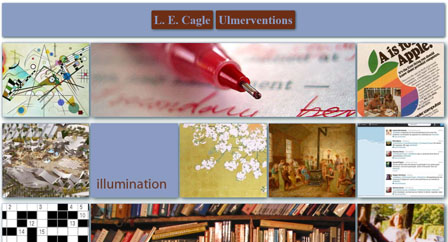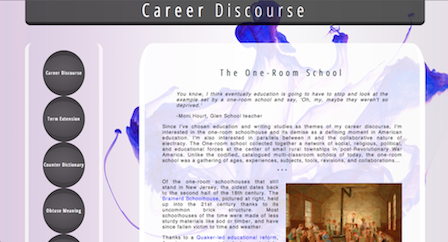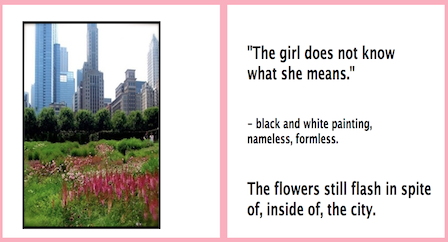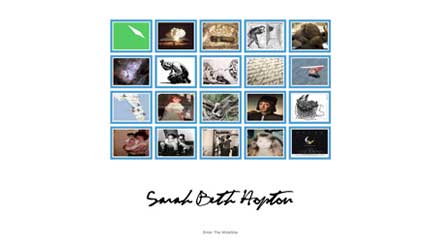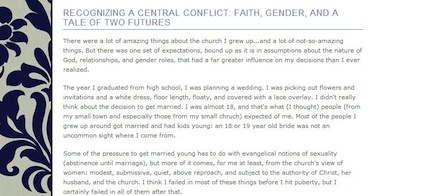Our [Electrate] Stories
Explicating Ulmer's Mystory Genre
Marc C. Santos, Ella R. Bieze, Lauren E. Cagle, Jason C., Zachary P. Dixon, Kristen N. Gay, Sarah Beth Hopton, Megan M. McIntyre
6. What else would you like to say?
Ella R. Bieze
The more distance I get from my mystory, the more I want to return to Gregory L. Ulmer’s project and do it again, and this time do it publicly. As challenging as I found the process of creating my own MyStory, and although I ultimately chose to keep mine private, I really believe it’s something worth doing multiple times, both for those creating their own mystories and for those reading/seeing/feeling others’ mystories. That being said, it is not an easy project. The tasks are often confusing, strange, and vague. They rely more on feelings, images, notions, and themes than on concrete questions with right or wrong answers. In creating my mystory, I was often left thinking about the assignments for a long time before coming up with ways to answer them, and I had to decide between the multiple answers I came up with, or combine them, or pick and choose pieces from them. Really, I hesitate to call those things I created answers to questions—they seem to have been more like responses to calls. Creating a mystory can thus be difficult, but I think that if we thoughtfully and creatively consider Ulmer’s calls and the responses we give to them, approaching both Ulmer’s project and our own projects with an open mind, there is an opportunity here to drastically shift the ways we think, the ways we create knowledge, and what, exactly, those knowledges look and feel like. Creating a mystory is not the same as simply coding a webpage, writing a narrative, or even designing an image: it is a multilayered, ebbing, flowing, interactive, subjective punctum. And ultimately, even though it’s strange, new, and different, it's incredibly exciting in its strangeness, newness, and difference. And although I struggled with it at times, I think, in the end, I like that it was a bit of a struggle.
Lauren E. Cagle
Although Ulmer allows for mystories to be created in analog as well as digital formats, I think it’s important to recognize what the digital promises that the analog does not. Digital work enjoys a kind of always-able-to-be-revised nature that mirrors the neverending tracing of the mystory. Like Paul Valery’s poems, mystories are never finished—just abandoned. In being abandoned, also, parts may die; bitrot constantly threatens the links on my homepage to external sites, such as classmates’ mystories, and even a Google doc with my initial postmortem on the project.
Even after being published, digital works always hold the potential for further revision and decay outside the author’s control. This potential reflects a deep difference between literate and electrate texts. In theory, all created work could be revised; in practice, however, the potential for revision in analog and digital formats differs vastly. When something is—bottom-line—nothing but 1’s and 0’s on a server, changing it may require the cutting of red tape, but it definitely requires the marshalling of few physical resources. In comparison, once something’s in print, that’s all she wrote. It’s done. The cost and effort of recalling and revising a print text are prohibitive. But knowledge in pixel form is imminently more flexible, which makes pixels the ideal container for the flexible and amorphous genre of the mystory.
Jason C.
I am left wondering at the role the mystory plays in changing the self—that is, in changing the reader/rhetor of Internet Invention (Ulmer, 2003) to better know him/herself in an electrate world. The mystory asks for a great deal of personal reflection, and often at the cost of reopening old wounds. Psychological ramifications abound in Internet Invention, and perhaps Ulmer is a bit cavalier in asking the EmerAgency to turn the tools of deconstruction on themselves.
There is, though, another way to see the mystory I think. I don't see Internet Invention as a way to deconstruct the self, as many will, but rather as a new way to construct it. For Ulmer, something has been lost about the self in the epoch of literacy, something that should be recovered in electracy. His utilization of Roland Barthes’ punctum elements of a photograph is one such relay for understanding what this loss means to electrate reasoning. Rather than tearing down—deconstructing—yet again, I found the mystory to be a collecting back of my personal relationship to learning. The mystory functioned for me as a way to gather elements of my relationship to the past—to see how digital meaning might be associated with emotions and the stings of Barthes’ punctum.
For Ulmer (2003), “electracy includes emotion in its model of reason” (p. 76). In this way, gathering back the punctum is a constructive enterprise, not a deconstructive one, as it gathers back the shed, punctum, elements of reason and the self. Though the mystories ask for a great deal of self-inspection, it does so with the intention of gathering up a few of the forgotten parts of one’s personal relationship to learning and inventing. For this alone it is refreshing for students like myself who are taught to value clarity (studium) and sterilize or forget the accidental (punctum).
Zachary P. Dixon
At the beginning of the mystory project, I was tremendously excited. I was captivated by the early chapters of Ulmer’s book and the way that he spoke about the development of a personal Wide Image and the possible identification of a life ”themata.” The possibility of identifying an overarching, guiding ethos—one which promised, like for Einstein, to guide me through the navigation of my life—was very alluring. I particularly enjoyed Ulmer’s presentation of the mystory as a sort of entrance into EmerAgency. The idea that a nonlinear, image-based narrative—centered around the punctum—could affect material change really spoke to my previous experiences in creative nonfiction, where the cathartic benefits of personal exposure and exploration is a familiar feeling.
In similar ways I think that the mystory has real value, mainly because of the rhetorical reflexivity that it demands. If you’re not struggling (even slightly) with what you produce—and how the medium enables this struggle—then you’re probably not doing it very well. As graduate students, struggling with the questions that the mystory raises (what to do, how to do it, personal limits, genre, and societal limits) is pretty critical. I really think the way that Ulmer asks us to engage with this project in ways that do not reflect traditional scholarly practices is also really valuable if for no other reason than those differences. Sometimes new and different are very good things.
Kristen N. Gay
We’re not in Kansas anymore. Ulmer (2003) claimed, “When you go online, even if your body is in Kansas, your spirit is not in Kansas anymore (to allude to the Wizard of Oz)” (p. 178). Like Dorothy and Toto traveling to Oz, making a mystory can feel like a whirlwind that remixes our identities, the worlds we live in, the monsters we fear, and the people we interact with until these things are indecipherable from each other. Like Dorothy, we may want to go home, but unlike Dorothy, we have no ruby slippers. The sting of the mystory, I think, is the realization that going home is impossible since home is always transforming around us—since home, it turns out, is and always has been shaped by interactions between forces that evade our control. Mapping felts is vital for egents to learn to navigate what Ulmer (2003) called “the experience of going online or putting your image into cyberspace” as it shows us that we have never been neatly in control (p. 178). And the mystory is essential in showing us ways to claim a measure of responsibility for (re)building homes for ourselves online that are attuned to others, complexly situated, and always shifting around us.
Sarah Beth Hopton
Interestingly, one of the revelations of the mystory concerned silence, or rather, staying silent and not telling the truth. I felt that sharing this revelation was proof positive of the work the mystory could do. In the end, I framed my wide emblem. It sits on my desk and acts as a reminder to approach learning and problems from various angles. I am reminded of a quote by Gilles Deleuze and Felix Guattari (1987): “Writing has nothing to do with signifying. It has to do with surveying, mapping, even realms that are yet to come” (pp. 4-5). Looked at one way, the mystory told the story of who I was and how I’d come to be her. Looked at another, its topography took the shape of intention, informed and made visible as much by who I was as by the re:vision of who I’d like to become.
Megan M. McIntyre
I’m not sure I was quite prepared, emotionally, for the requirements of this project. Reading about postpedagogy’s valuation of the affective dimension, about the concern of feminist pedagogues with making space for emotion and irrationality in pedagogy, does not necessarily prepare one for facing many of the best and worst moments of one’s life. Remembering is hard; I need to remember that.
